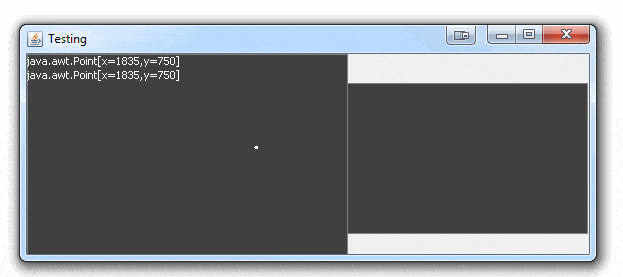我在网上搜索了一段时间,但并没有找到解决我的问题的方法。 我知道可以使用以下代码获取当前鼠标位置:
PointerInfo a = MouseInfo.getPointerInfo();
Point b = a.getLocation();
问题在于我只能获取相对于主屏幕的鼠标位置,这是在多屏环境下。这意味着如果第二个屏幕在主屏幕左侧,我会收到例如X:-917.0位置Y:-137.0的值。我知道这些值取决于屏幕分辨率和监视器的顺序。 是否有可能获取当前活动屏幕上的鼠标位置?
此致敬礼
我在网上搜索了一段时间,但并没有找到解决我的问题的方法。 我知道可以使用以下代码获取当前鼠标位置:
PointerInfo a = MouseInfo.getPointerInfo();
Point b = a.getLocation();
PointerInfo 并从中减去 GraphicsDevice 的边界,如果结果小于 0(因为屏幕在主屏幕的左侧),我将结果乘以 -1。// Pointer info
PointerInfo pi = MouseInfo.getPointerInfo();
Point mp = pi.getLocation();
// The devices bounds
Rectangle bounds = getDeviceBounds(pi.getDevice());
// Create new "virtual" point based on the mouse point
virtualPoint = new Point(mp);
// Subtract the x/y position of the device
virtualPoint.x -= bounds.x;
virtualPoint.y -= bounds.y;
// Clip negative values...
if (virtualPoint.x < 0) {
virtualPoint.x *= -1;
}
if (virtualPoint.y < 0) {
virtualPoint.y *= -1;
}
MouseInfo报告)在第一行,第二行显示了在GraphicsDevice上下文中的“屏幕”位置。

import java.awt.BorderLayout;
import java.awt.Color;
import java.awt.Dimension;
import java.awt.EventQueue;
import java.awt.FontMetrics;
import java.awt.Graphics;
import java.awt.Graphics2D;
import java.awt.GraphicsConfiguration;
import java.awt.GraphicsDevice;
import java.awt.GraphicsEnvironment;
import java.awt.MouseInfo;
import java.awt.Point;
import java.awt.PointerInfo;
import java.awt.Rectangle;
import java.awt.event.ActionEvent;
import java.awt.event.ActionListener;
import java.util.ArrayList;
import java.util.List;
import javax.swing.JFrame;
import javax.swing.JPanel;
import javax.swing.Timer;
import javax.swing.UIManager;
import javax.swing.UnsupportedLookAndFeelException;
public class WheresMyMouse {
public static void main(String[] args) {
new WheresMyMouse();
}
public WheresMyMouse() {
EventQueue.invokeLater(new Runnable() {
@Override
public void run() {
try {
UIManager.setLookAndFeel(UIManager.getSystemLookAndFeelClassName());
} catch (ClassNotFoundException | InstantiationException | IllegalAccessException | UnsupportedLookAndFeelException ex) {
}
JFrame frame = new JFrame("Testing");
frame.setDefaultCloseOperation(JFrame.EXIT_ON_CLOSE);
frame.setLayout(new BorderLayout());
frame.add(new TestPane());
frame.pack();
frame.setLocationRelativeTo(null);
frame.setVisible(true);
}
});
}
public class TestPane extends JPanel {
private double scale;
private List<Rectangle> screenBounds;
private Point virtualPoint;
private Point screenPoint;
public TestPane() {
screenBounds = getScreenBounds();
Timer timer = new Timer(40, new ActionListener() {
@Override
public void actionPerformed(ActionEvent e) {
PointerInfo pi = MouseInfo.getPointerInfo();
Point mp = pi.getLocation();
Rectangle bounds = getDeviceBounds(pi.getDevice());
screenPoint = new Point(mp);
virtualPoint = new Point(mp);
virtualPoint.x -= bounds.x;
virtualPoint.y -= bounds.y;
if (virtualPoint.x < 0) {
virtualPoint.x *= -1;
}
if (virtualPoint.y < 0) {
virtualPoint.y *= -1;
}
repaint();
}
});
timer.start();
}
@Override
public void invalidate() {
super.invalidate();
Rectangle virtualBounds = getVirtualBounds();
scale = getScaleFactorToFit(virtualBounds.getSize(), getSize());
}
@Override
public Dimension getPreferredSize() {
return new Dimension(200, 200);
}
@Override
protected void paintComponent(Graphics g) {
super.paintComponent(g);
Graphics2D g2d = (Graphics2D) g.create();
int xOffset = 0;
int yOffset = 0;
List<Rectangle> scaledBounds = new ArrayList<>(screenBounds.size());
for (Rectangle bounds : screenBounds) {
bounds = scale(bounds);
scaledBounds.add(bounds);
if (bounds.x < xOffset) {
xOffset = bounds.x;
}
if (bounds.y < yOffset) {
yOffset = bounds.y;
}
}
if (xOffset < 0) {
xOffset *= -1;
}
if (yOffset < 0) {
yOffset *= -1;
}
for (Rectangle bounds : scaledBounds) {
bounds.x += xOffset;
bounds.y += xOffset;
g2d.setColor(Color.DARK_GRAY);
g2d.fill(bounds);
g2d.setColor(Color.GRAY);
g2d.draw(bounds);
}
FontMetrics fm = g2d.getFontMetrics();
g2d.setColor(Color.WHITE);
if (screenPoint != null) {
int x = 0;
int y = fm.getAscent();
g2d.drawString(screenPoint.toString(), x, y);
screenPoint.x += xOffset;
screenPoint.y += yOffset;
screenPoint.x *= scale;
screenPoint.y *= scale;
g2d.fillOval(screenPoint.x - 2, screenPoint.y - 2, 4, 4);
}
if (virtualPoint != null) {
int x = 0;
int y = fm.getAscent() + fm.getHeight();
g2d.drawString(virtualPoint.toString(), x, y);
}
g2d.dispose();
}
protected Rectangle scale(Rectangle bounds) {
Rectangle scaled = new Rectangle(bounds);
scaled.x *= scale;
scaled.y *= scale;
scaled.width *= scale;
scaled.height *= scale;
return scaled;
}
}
public static Rectangle getScreenBoundsAt(Point pos) {
GraphicsDevice gd = getGraphicsDeviceAt(pos);
Rectangle bounds = null;
if (gd != null) {
bounds = gd.getDefaultConfiguration().getBounds();
}
return bounds;
}
public List<Rectangle> getScreenBounds() {
List<Rectangle> bounds = new ArrayList<>(25);
GraphicsDevice device = null;
GraphicsEnvironment ge = GraphicsEnvironment.getLocalGraphicsEnvironment();
GraphicsDevice lstGDs[] = ge.getScreenDevices();
ArrayList<GraphicsDevice> lstDevices = new ArrayList<GraphicsDevice>(lstGDs.length);
for (GraphicsDevice gd : lstGDs) {
GraphicsConfiguration gc = gd.getDefaultConfiguration();
Rectangle screenBounds = gc.getBounds();
bounds.add(screenBounds);
}
return bounds;
}
public static Rectangle getDeviceBounds(GraphicsDevice device) {
GraphicsConfiguration gc = device.getDefaultConfiguration();
Rectangle bounds = gc.getBounds();
return bounds;
}
public static GraphicsDevice getGraphicsDeviceAt(Point pos) {
GraphicsDevice device = null;
GraphicsEnvironment ge = GraphicsEnvironment.getLocalGraphicsEnvironment();
GraphicsDevice lstGDs[] = ge.getScreenDevices();
ArrayList<GraphicsDevice> lstDevices = new ArrayList<GraphicsDevice>(lstGDs.length);
for (GraphicsDevice gd : lstGDs) {
Rectangle screenBounds = getDeviceBounds(gd);
if (screenBounds.contains(pos)) {
lstDevices.add(gd);
}
}
if (lstDevices.size() == 1) {
device = lstDevices.get(0);
}
return device;
}
public static Rectangle getVirtualBounds() {
Rectangle bounds = new Rectangle(0, 0, 0, 0);
GraphicsEnvironment ge = GraphicsEnvironment.getLocalGraphicsEnvironment();
GraphicsDevice lstGDs[] = ge.getScreenDevices();
for (GraphicsDevice gd : lstGDs) {
bounds.add(getDeviceBounds(gd));
}
return bounds;
}
public static double getScaleFactor(int iMasterSize, int iTargetSize) {
double dScale = 1;
dScale = (double) iTargetSize / (double) iMasterSize;
return dScale;
}
public static double getScaleFactorToFit(Dimension original, Dimension toFit) {
double dScale = 1d;
if (original != null && toFit != null) {
double dScaleWidth = getScaleFactor(original.width, toFit.width);
double dScaleHeight = getScaleFactor(original.height, toFit.height);
dScale = Math.min(dScaleHeight, dScaleWidth);
}
return dScale;
}
}
private Point mousePosition ()
{
final PointerInfo pi = MouseInfo.getPointerInfo ();
final Point mp = pi.getLocation ();
SwingUtilities.convertPointFromScreen (mp, this);
return mp;
}